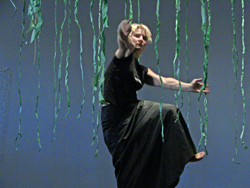The world premiere of Tedd Robinson’s production Reclusive Conclusions and other duets is definitely one of the highlights of dance in the nation’s capital this season. In a break from his self-labelled “reclusive existence” as a solo artist, the Ottawa-based Robinson choreographed three duets for himself and guest artists Mako Kawano, Louise Lecavalier and Margie Gillis.
Now the artistic director of 10 Gates Dancing Inc., Robinson was a practicing monk of hakukaze soto zen in Ottawa from 1994 to 2000. Beyond his shaved head, the experience as a monk arguably has facilitated his entrance into a phase of theatrical distillation well suited to the intimate Studio Theatre in the National Arts Centre. While the stylistic individuality of Robinson’s three partners gave the evening diversity, his minimalist aesthetic provided cohesiveness. With help from colleagues Norman Vandal, Yso, Dubuc and Kaliyana, for instance, Robinson dresses all the dancers and musicians in dark, muted material. “Scenery” is limited to the musicians’ onstage instruments. Jean Philippe Trépanier’s lighting moodily and subtly manipulates the performance space through its palette of shadows.
The first work, “Kurosango”, is by far the most dramatic statement of the evening. It begins with Kawano and Robinson standing in a rectangle of light upstage, their heads bowed. On stage, celebrated Canadian pianist Eve Egoyan plays Alvin Currans haunting “For Cornelius”. The music’s melancholic beginning soon modulates into something more predatory through an increasingly agitated tremolo.
The program notes indicate that the title of this work, “Kurosango”, means “black coral” in Japanese — a type of coral whose stocks are rapidly and irrevocably being depleted. Trépanier’s lighting projection on the floor and wings invokes a coralloid silhouette, but just as easily suggests a ring of thorns or barbed wire. The resulting atmosphere, whatever one’s interpretation, is disturbing.
As soon as Kawano begins to move it is clear she is a rare performer. Her physical fragility, defined by her long slender limbs, and seemingly natural fluidity, contrast and accent the lexicon of fractured movement she articulates. A beautiful high extension of her leg ends in a flopping foot and spastic toes. The graceful lines of her arms are shattered by hands that seize into claws and snap back at her wrists. Her torso teeters precariously on her pelvis as if her spine is about to collapse. She looks like she is dancing with a body of broken bones. She writhes on the floor. She mumbles frantically under her breath in Japanese. Performed by another dancer, this role might descend into self-indulgence, but Kawano is so committed to the movement and so in control of her performance that she is utterly compelling.
Throughout this physical statement by Kawano, Robinson remains relatively still. At times he appears to be a surrogate for the audience, concerned but unable to assist. At other moments though, when he stands upstage in his long black coat, quietly watching Kawano, his presence hints at a more sinister relationship.
“Lula and the Sailor” is less interesting choreographically than “Kurosango”, but is a more cerebral work. It is performed by Robinson and Lecavalier, who are contained by a large white square that serves as their performance space. On a smaller adjacent white mat, Yannick Rieu provides a soundscape of birds and saxophones in his electronic and live accompaniment.
In this piece, Robinson appears to be playing with the concept of opposites: nature and technology; the dancers’ black costumes set against the white floor; Lecavalier’s frenetic movements centre stage versus Robinson, who rocks his hips side to side on the periphery of the square. Far from attempting to move towards resolution through homogenization of these polarities, the work instead emphasizes plurality and balance.
Gone are the platinum tresses of her days with La La La Human Steps, but Lecavalier is still as precise, still as fast, still as fearless as ever. She shows that she need not defy gravity by spinning across the stage on a horizontal axis, or lift men twice her size to elicit awe from spectators. In “Lula and the Sailor”, she simply brings her hands together and flutters her fingers like a bird’s wings. The gesture is small, but the effect is so realistic it becomes a testament to her power as a stage performer.
In the final duet of the evening, “The Insistent Echo of Reclusive Conclusions”, a nostalgic quality of whimsy pervades. It is easy to imagine Gillis and Robinson, who choreographed the piece together, tossing ideas back and forth in the studio as they explore themes of convergence and loss.
The most effective moments of this work are when Gillis and Robinson evoke children learning to communicate through gesture by using Gillis’ long red hair as their metaphoric means of speech. One minute her hair is fire. The next, it is a rope. Gillis tosses her head back and strands linger on her face. Cobwebs. She drapes her hair over her arms and hovers over Robinson who suddenly looks like Buddha sitting under the Bodhi tree.
While Gillis and Robinson are busy constructing a corporeal language, Linda Rabin unspools her voice back to a primal, pre-verbal state. Rabin, a well-known Montréal dance artist and teacher, joins the duo on stage, sitting off to one side. As taped music by Schumann and John Wyre plays, she improvises vocalizations, from soft laughing and gurgling to more guttural noises.
Robinson is undoubtedly an acquired taste. Those people who prefer literal and narrative art will no doubt find these duets perplexing. Others, hoping for the kitschy and humorous theatricality found in some of his earlier choreography, will also be disappointed. Reclusive Conclusions and other duets is for audiences who like their dance sleek but not glib. This production shows that Robinson’s latest choreography is sometimes sexy, sometimes edgy, but always intelligently crafted and skillfully performed.
Tagged: Contemporary, Performance, ON , Ottawa




